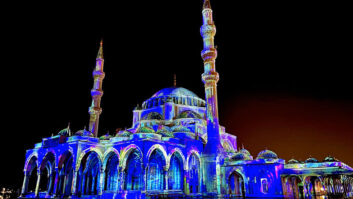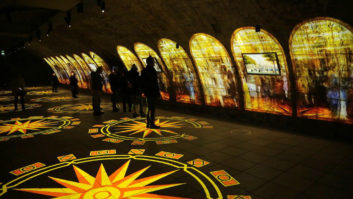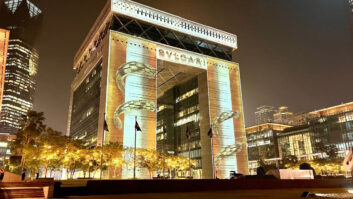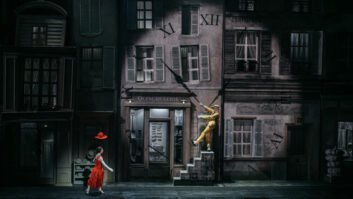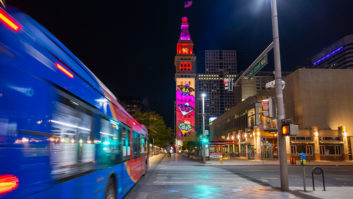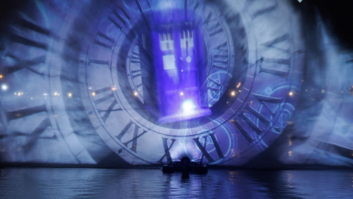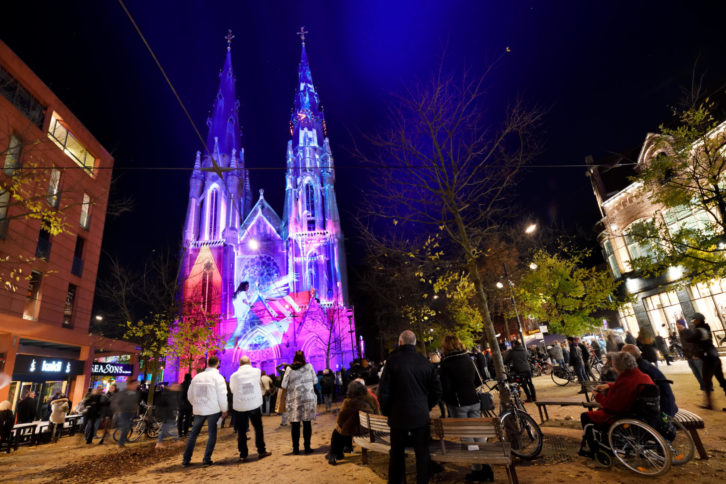
Having previously looked at the rapid advances in projection mapping that have removed many restrictions to its deployment, here Rob Lane considers the balance between software and hardware innovations and whether fixed installations may soon overtake live event applications.
The development of automated software allowing the creation of simple projection mapping designs has led to a “democratisation” of the art form, according to Bigg – as well as making it more cost effective to deploy. At the same time, media server processing has evolved to be bigger, better and faster. Add motion capture into the mix and the boundaries of creativity have been greatly expanded, with designers being to achieve interactive immersive projections that excite and engage on a whole different level.
“Predominantly the innovations we are seeing are more software-led,” explains Earls. “While new projector models are getting smaller, brighter and more efficient, their specifications otherwise remain consistently standard. At White Light, we frequently work with disguise, whose technology is ever evolving. In the first instance, a virtual model of the projection site is created via laser scanning and then imported directly into the workflow so that this can be developed remotely. The disguise OmniCal solution offers a camera-based projector calibration system enabling fast install and accuracy, which is high priority for the seamless delivery of live events.”
Ross Noonan, UK technical product specialist at Optoma, agrees that innovations are “nearly always” software-based, but as a projection specialist he acknowledges the projector’s contribution to mapping’s popularity. “Of course you need capable hardware to run the software,” he says. “The more complex the mapping project, the more comprehensive the hardware needs to be to run the mapping software package. And this is becoming easier to do. With the emergence of tablet and phone apps, the simplicity is now starting to creep into the world of professional mapping.”
According to Noonan, it’s possible that we may see mapping technology built into projectors, much in the same way that blending functionality is now common in high-end projectors. Built-in mapping technology would obviously be something of a boon, perhaps with fixed installations benefitting particularly – an area that is growing, according to some commentators, faster than all of the other mapping beneficiaries.
Best suited
In spite of the fact that it’s become easier and less expensive to deliver than in the past, projection mapping still requires a big investment in time and money. As a result, it’s best suited to large, spectacular events and fixed installs, where clients will achieve a return on their investment.
“As technology becomes more affordable and the design aspect becomes more ‘computer-aided’ it opens the possibilities of using projection mapping in more fixed applications”
Emma Bigg, Octavius RE
“I think in most areas we’ve seen fixed installations overtake live event in terms of value of business, and there is no reason to think this won’t happen with projection mapping,” says Bigg. “As technology becomes more affordable and the design aspect becomes more ‘computer-aided’ it opens the possibilities of using projection mapping in more fixed applications.”
“From our point of view the main part is still to be found at the live events,” opines Hocke. “It can be assumed, however, that in the future more and more complex installations will be able to go into permanent operation, because here too the software and hardware will continue to develop further.”
Live events utilising projection mapping tend to be music-based (Glastonbury being a case in point), whereas fixed installation tends to be most popular in retail POS or immersive spaces. “There isn’t really a difference between live event mapping and fixed install other than one being more permanent,” explains Noonan. “The methods and aims of the technology are the same – to bring inanimate objects to life.”
“It is obvious that the share of fixed installation is increasing rapidly,” says Toulot. “The live event market seems to be mature and stable. For fixed installation, demand is increasingly strong, new markets appear every year and it is easy to believe that this will accelerate in the coming years.”
Within install environments, mapping only becomes cost-effective if the projectors are frequently used for continual rolling content, rather than a one-off ‘show’. “The market demands that we are seeing are still very heavily weighted towards hire and live events,” says Earls. “We do not see this changing in the near future, as projection mapping is most effectively utilised for instant and often brief visual impact.”
In general, there does seem to be a shift towards more fixed or semi-permanent installs, alongside a general embracing of digital technology within art and culture – all aiding the growth of projection mapping.
Further developments
The world’s first digital art museum opened in Japan last year, utilising projection mapping to display art in such a way that enabled visitors to feel like they were inside the art not just observers. And Paris’ Digital Art Centre, L’Atelier des Lumineires is also an excellent example of a fixed projection mapping installation.
“I believe that there will be a development in using projection mapping in the meeting room world,” says Biggs. “What better way to look at 3D designs but in 3D, and to be able to manipulate the image for an insightful and productive discussion?
“It could also be used to transform higher education and training. We are already seeing a trend to using immersive, AR and VR in these areas, so I think projection mapping could be a key component in developing these concepts further.”
Currently, projection mapping tends to be used in retail, museums, visitor centres, theme parks and – of course – for product launches and brand marketing. It is also being embraced by corporates, and the construction and travel industries, with fixed installations key to mapping’s growth in these areas.
“Clients are being asked to develop experiences that attract people somewhere rather than events that excite guests for an hour or less on a special occasion,” explains Mills. “That trend speaks to the power of projection mapping as a medium to touch more people than ever before and as a unique way to draw people back to a specific venue.”
www.annavalley.co.uk
www.christiedigital.com
www.macom.de
www.octaviusre.com
www.optoma.com
www.whatsit.fr/en
www.whitelight.ltd.uk

